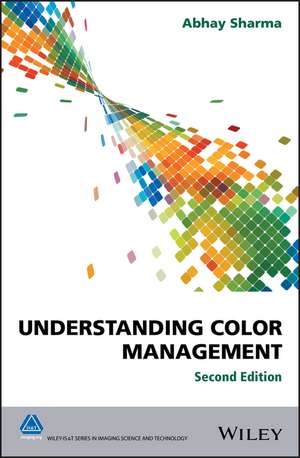Understanding Color Management 2e: The Wiley-IS&T Series in Imaging Science and Technology
Autor A Sharmaen Limba Engleză Hardback – 30 aug 2018
Preț: 691.37 lei
Preț vechi: 759.75 lei
-9% Nou
Puncte Express: 1037
Preț estimativ în valută:
132.30€ • 138.76$ • 110.13£
132.30€ • 138.76$ • 110.13£
Carte tipărită la comandă
Livrare economică 01-15 aprilie
Preluare comenzi: 021 569.72.76
Specificații
ISBN-13: 9781119223634
ISBN-10: 1119223636
Pagini: 344
Dimensiuni: 170 x 244 x 18 mm
Greutate: 0.82 kg
Ediția:2nd Edition
Editura: Wiley
Seria The Wiley-IS&T Series in Imaging Science and Technology
Locul publicării:Chichester, United Kingdom
ISBN-10: 1119223636
Pagini: 344
Dimensiuni: 170 x 244 x 18 mm
Greutate: 0.82 kg
Ediția:2nd Edition
Editura: Wiley
Seria The Wiley-IS&T Series in Imaging Science and Technology
Locul publicării:Chichester, United Kingdom
Notă biografică
Cuprins
Foreword to 2nd Edition xv Foreword to 1st Edition xvii Preface xix Acknowledgments xxvii 1 Introduction 1 1.1 Why Do We Need Color Management? 1 1.2 Closed-loop Color Control 3 1.3 Need for an Open System 4 1.4 A Color Management System 5 1.5 Color Management Workflows 8 1.6 ICC - International Color Consortium 10 1.7 RGB and CMYK Color Specification 13 1.8 CIE 1931 Yxy and CIE 1976 L¯*a¯*b¯* 16 1.9 Color Conversions 17 1.10 Three Cs of Color Management 19 1.11 Profile Types 20 1.11.1 Custom Profiles 20 1.11.2 Generic Profiles 21 1.11.3 Standard Profiles 22 1.12 Color Gamuts 24 1.13 Rendering Intents 26 1.14 Color Accuracy 28 1.15 Late-binding Workflows 29 1.16 Spot Colors and Proprietary Systems 30 1.17 Benefits of Color Management 31 1.18 Summary 34 2 Principles of Light and Color 37 2.1 Introduction 37 2.2 Light Source - Object - Human Observer 38 2.3 Electromagnetic Radiation 39 2.3.1 The Visible Spectrum 39 2.4 Specifying the Light Source 40 2.4.1 Spectral Power Distribution 40 2.4.2 Color Temperature 42 2.4.3 CIE Illuminants and Standard Sources 43 2.4.4 Viewing Booths 45 2.4.5 "Warm" and "Cold" Colors 46 2.5 Measuring the Sample Spectrum 46 2.5.1 Practical Color Samples 47 2.6 Quantifying Human Color Vision 49 2.6.1 CIE Standard Observer 50 2.6.2 Trichromatic Vision 51 2.7 Changing the Light Source 53 2.7.1 Chromatic Adaptation 53 2.7.2 Yellow Sodium-Vapor Street Lighting 54 2.7.3 Metamerism - Matching Jacket and Trousers 56 2.7.4 PANTONE(r) D50 Lighting Indicator 58 2.8 Vision and Measurement 58 2.8.1 Viewing the Invisible - Infrared 59 2.8.2 Ultraviolet Fluorescence 60 2.8.3 Color Illusions 60 2.8.4 Color Appearance Modeling 61 2.9 Summary 63 3 Color by Numbers 65 3.1 Introduction 65 3.2 Basic Attributes of Color: Hue, Saturation, and Lightness 66 3.3 Munsell Color System 67 3.4 CIE Color Specification 68 3.5 XYZ Tristimulus Values 69 3.5.1 Calculating XYZ 69 3.5.2 XYZ Example Colors 71 3.5.3 XYZ for Light Sources 72 3.6 CIE 1931 Yxy System 72 3.6.1 Advantages of the Yxy Chromaticity Diagram 74 3.6.2 Disadvantages of the Yxy Chromaticity Diagram 75 3.7 CIE 1976 L¯*a¯*b¯* System 77 3.7.1 L¯*a¯*b¯* Practical Examples 80 3.7.2 L¯*a¯*b¯* vs. Spectral Data 82 3.8 CIE 1976 L¯*C¯*h 83 3.9 Quantifying Color Difference 84 3.9.1 Calculating DeltaE 85 3.9.2 Improved DeltaE Equations 88 3.9.3 Which DeltaE Should I Use? 91 3.9.4 DeltaE and Images 92 3.10 Summary 93 4 Measuring Instruments 95 4.1 Introduction 95 4.2 Instrument Types 96 4.3 Instrument Filter Bands 97 4.4 Densitometers 98 4.4.1 Density Equation 99 4.4.2 Status Densitometry 99 4.4.3 Density and Process Control 100 4.5 Colorimeters 101 4.5.1 Filter-based Colorimetry 101 4.5.2 Improvements in Display Colorimeters 103 4.6 Spectrophotometers 104 4.6.1 Spectrophotometer Features and Functions 106 4.6.2 Ever Popular X-Rite i1Pro2 109 4.6.3 OBA and UV Fluorescence 110 4.6.4 M0, M1, M2, M3 Measurement Modes 111 4.7 Smartphone and Other Low-cost Systems 114 4.8 Inter-instrument and Inter-model Agreement 115 4.9 Instrument Repeatability vs. Accuracy 116 4.10 Instrument Calibration 117 4.11 Summary 120 5 Inside Profiles 121 5.1 Introduction 121 5.2 ICC Profile Specification 122 5.3 Hexadecimal Profile Encoding 123 5.4 Structure of an ICC Profile 124 5.5 Profile Header 124 5.5.1 Preferred CMM 125 5.5.2 Specification Version 125 5.5.3 Profile Class 126 5.5.4 Data Color Space and PCS 127 5.5.5 Flags 128 5.5.6 Rendering Intent 130 5.5.7 PCS Illuminant 130 5.5.8 Profile Creator 130 5.6 Tag Table 131 5.6.1 Profile Description Tag 131 5.6.2 XYZ Primaries Tag 132 5.6.3 Tone Reproduction Curve Tag 133 5.6.4 Media White Point Tag 133 5.6.5 Chromatic Adaptation Tag 133 5.6.6 Lookup Table Tags 135 5.6.7 Target Tag 137 5.6.8 Gamut Tag 139 5.6.9 Optional Tags 139 5.6.10 Private Tags 140 5.7 Version 2 and Version 4 Profiles 140 5.8 Version 5 Profiles and iccMAX 141 5.9 How Does a Lookup Table Work? 142 5.10 Summary 144 6 Managing Color in Digital Cameras 147 6.1 Introduction 147 6.2 Scanner Profiling 148 6.2.1 Making a Scanner Profile 148 6.3 Paradigm Shift from Scanners to Digital Cameras 149 6.4 Color Management for a Digital Camera 152 6.4.1 Bayer Color Filter Array 152 6.4.2 In-Camera JPEG Processing 153 6.4.3 Camera RAW Processing 154 6.4.4 Camera RAW Color Management 155 6.4.5 Creating a Camera RAW Profile 157 6.4.6 Digital Negative - DNG 157 6.5 File Formats for Digital Cameras 159 6.5.1 JPEG Lossy File Format 160 6.5.2 TIFF Lossless File Format 161 6.6 Studio Color Management 161 6.7 Summary 162 7 Monitor Profiles 165 7.1 Introduction 165 7.2 Three Cs of Monitor Profiling 167 7.3 Monitor Profiling Solutions 167 7.3.1 Free Utilities 167 7.3.2 Commercial Profiling Software 168 7.3.3 Integrated Soft Proofing Solutions 169 7.3.4 Hardware Calibrated Monitor Systems 170 7.4 Monitor Basics 171 7.4.1 External Brightness and Contrast 171 7.4.2 RGB Primaries 172 7.4.3 White Point 174 7.4.4 Monitor Gamma 174 7.4.5 Luminance Levels 175 7.4.6 The Dingy Yellow Effect 175 7.5 Making a Monitor Profile 177 7.6 Checking a Monitor Profile 178 7.7 Monitor Profiles and Windows 179 7.8 Monitor Profiles and Web Browsers 180 7.9 Monitor Profiles and Mobile Devices 181 7.10 Soft Proofing in Adobe Acrobat 182 7.11 Standards for Viewing Booths 183 7.12 Summary 184 8 Press and Printer Profiling 187 8.1 Introduction 187 8.2 The Three Cs in Printer Profiling 188 8.3 Calibration in Inkjet Systems 188 8.3.1 Ink Limiting 189 8.3.2 Ink Hooking 190 8.3.3 Ink Splitting 191 8.4 Calibration in Digital Presses 192 8.5 Calibration in Offset Printing 193 8.5.1 G7 Calibration 194 8.5.2 Shared Neutral Appearance vs. Full Color Match 196 8.6 Printer Test Charts 197 8.6.1 Commonly Used Printer Test Charts 197 8.6.2 Visual vs. Random Layout 199 8.7 Printing and Measuring the Test Chart 200 8.7.1 RGB or CMYK or Halftone Printer? 200 8.7.2 Printing with "No Color Management" 202 8.7.3 Layout for Different Measuring Instruments 204 8.7.4 White Backing 205 8.7.5 Examining the Measurement File 205 8.7.6 Averaging Measurement Files 206 8.8 Making a Printer Profile 206 8.8.1 Black Channel Generation 206 8.8.2 Profile Quality 209 8.9 Checking the Printer Profile 210 8.9.1 Quantitative Checking 210 8.9.2 Qualitative Checking 212 8.10 Reference Printing Conditions 213 8.10.1 Developing Reference Printing Conditions 214 8.10.2 American and European Reference Printing Conditions 215 8.10.3 Using Reference Printing Conditions in Prepress and Press 217 8.10.4 "Printing to the Numbers" 219 8.11 Rendering Intents 221 8.11.1 Perceptual Rendering Intent 222 8.11.2 Relative Colorimetric Rendering Intent 223 8.11.3 Absolute Colorimetric Rendering Intent 224 8.11.4 Saturation Rendering Intent 225 8.12 Device LinkWorkflows 225 8.12.1 ICC Device Linking 225 8.12.2 Proprietary Device Linking 226 8.13 Process Control in Printing 227 8.14 Summary 230 9 Spot Colors & Expanded Gamut Printing 233 9.1 Introduction 233 9.2 Specifying a Spot Color - PANTONE MATCHING SYSTEM(r) 236 9.2.1 PANTONE Guides 236 9.2.2 Pantone Digital Color Libraries 239 9.2.3 PANTONE Ink Formulation Recipes 241 9.2.4 Advantages and Disadvantages of the PMS System 242 9.3 Printing a Spot Color 243 9.3.1 Printing with a Spot Color Ink 243 9.3.2 Simulating a Spot Color in CMYK 244 9.4 Spot Colors and Digital Presses 246 9.4.1 Creating a Swatch Book on a Digital Press 247 9.4.2 Spot Color Matching in Digital Presses 247 9.4.3 Spot Color Editor for a Digital Press 249 9.5 Expanded Gamut Printing 249 9.6 Software Solutions for Spot Colors and Expanded Gamut Printing 253 9.6.1 Gamut Warning in Adobe Photoshop 253 9.6.2 Using PANTONE Color Manager 253 9.6.3 Color Conversion with Esko Equinox 254 9.6.4 Gamut Calculation in Esko Color Engine Pilot 255 9.7 Summary 256 10 XML and Color Management 259 10.1 Introduction 259 10.2 Markup Languages 260 10.3 XML Design Principles 261 10.4 Basics of XML 262 10.4.1 Declaration 262 10.4.2 Elements 263 10.4.3 Attributes 263 10.4.4 Schema 264 10.4.5 Private Schemas 265 10.4.6 Validation and Conformance 265 10.5 Working with XML 267 10.5.1 iccMAX 267 10.5.2 Windows Color System (WCS) 268 10.5.3 Color Exchange Format (CxF) 269 10.5.4 X-Rite i1Profiler 271 10.5.5 JDF 272 10.6 XML not-best Practices 272 10.7 Summary 274 11 Color Management in Photoshop 275 11.1 Introduction 275 11.2 Photoshop Through the Ages 276 11.3 Photoshop's Color Management Rules 278 11.3.1 Rule 1: Image + Profile 279 11.3.2 Rule 2: Profile - Connection Space - Profile 279 11.3.3 Rule 3: Real vs. Simulated Conversions 279 11.4 Photoshop's Working Space 280 11.5 Menus in Photoshop 281 11.5.1 Opening an Image 282 11.5.2 Image Status 283 11.5.3 Color Settings 284 11.5.4 Assign Profile 286 11.5.5 Convert to Profile 287 11.5.6 Soft Proof Setup 289 11.6 Photoshop and Printing 290 11.6.1 Photoshop's Print Settings 290 11.6.2 Hard Proofing 292 11.7 Putting It All Together 293 11.8 Summary 295 A Appendix 297 Index 305

































